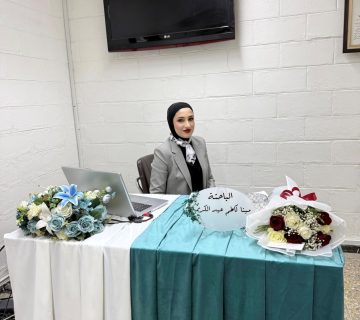Environmental Engineering Department at the College of Engineering, University of Baghdad, held PhD dissertation examination on Monday 27\11\2023 titled:
“Electromembrane extraction of heavy metals from aqueous solutions using supported liquid membrane”
By the student Noor Ragheb Khadom Jabbar and supervised by Assist. Prof. Dr. Hussein Majeed Flayeh and Prof. Dr. Ali Hussein Abbar. The examination committee consisted of Prof. Dr. Zainab Ziad Ismail as Chairman, and the membership of Prof. Dr. Khalid Ajmy Sukkar, Prof. Dr. Abeer Ibrahim Musa, Prof. Dr. Mohaned Jasim Mohammed Ridha, and Prof. Dr. Ziad Tariq Abd Ali. After conducting the public discussion and listening to the student’s defense, the dissertation was accepted with excellent degree. It was summarized as follows:
Contaminating water with toxic metals is a global concern. Electro-membrane processes, like electrodialysis and electrodeionization, using ion-exchange membranes and electric potential, offer a natural solution for removal. This research investigates the implementation of an Electromembrane Extraction (EME) system to remove heavy metals (copper, cobalt, cadmium, and zinc) from aqueous solutions. Using a unique electrochemical cell design with graphite anode, stainless-steel cathode, and Supported Liquid Membrane (SLM), the study examines the influence of factors such as carrier choice (DEHP, TEHP), applied voltage (20-60V), initial pH (3-8), and metal concentration (5-25ppm) on removal efficiency for each metal. The carriers Tris(2-ethylhexyl) phosphate (TEHP) and bis(2-ethylhexyl) phosphate (DEHP), along with 1-octanol, are explored. The aim is to provide insights into key parameters affecting heavy metal removal through EME. Results showed a significant impact of applied voltage on enhancing the removal efficiency of each metal using the membrane. Optimal operating conditions were determined through meticulous optimization: 1-octanol with 1.0% v/v bis(2-ethylhexyl) phosphate as the carrier, a voltage of 60 V, initial pH of 5, initial metal concentration of 15 ppm, 6-hrs. extraction, and a stirring rate of 1000 rpm. Remarkably, under these optimized conditions, impressive removal efficiencies were achieved for each heavy metal individually: 88% for copper, 87% for cobalt, 90% for cadmium, and 87.3% for zinc. A comparison with the scenario of no applied voltage highlights the substantial increase in removal efficiency, underscoring the potential effectiveness of the EME technique for eliminating heavy metals from aqueous solutions. Results showed that the pH of the donor always declines with time while the pH of the acceptor increases initially and then starts to decline. The concentration of each metal at the accepter phase has different behavior depending on the operating parameters, the electrode potential, and the effect of hydrogen evolution on the cathode. First-order Kinetics study showed that the relation between ln (C/Co) vs. time for copper removal was almost linear with a determinant coefficient R2 not less than 0.99 confirming that the system obeyed a first order kinetic and it was under mass transfer control. Response Surface Methodology (RSM) optimized conditions for copper removal, emphasizing the significance of squared interaction (70.5%) and pH. Optimal parameters: 60V applied voltage, pH 5.18, and initial copper concentration of 5 ppm. During operation, copper decreased to 1.6 ppm, yielding an 80% removal efficiency. This research demonstrates the potential of electromembrane extraction as an efficient and promising method for the removal of heavy metals, providing valuable insights for future applications in environmental and water treatment processes.








